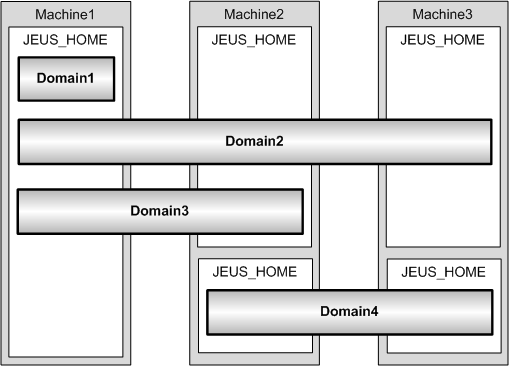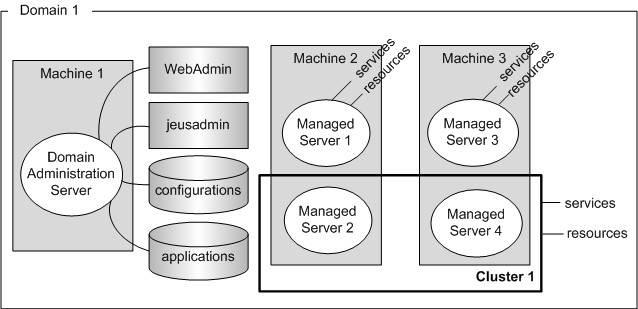Table of Contents
This chapter describes the concepts and architecture of a domain.
A domain is the basic unit of management. It consists of multiple servers and clusters that are divided according to tasks.
Services, server locations, and security policies can be different for each domain. Each domain has a separate configuration file and does not share settings with other domains. Domains should be created with the knowledge that the security configuration, applications, and resources are shared within each domain.
Consider the following when creating a domain:
-
Role of a server
-
A domain consists of related applications.
-
-
Physical location of the server
-
To provide stable services, the physical location of the servers is important.
-
-
Load on the servers
-
Use an appropriate number of servers based on the required workload.
-
Each machine requires an instance of JEUS (installed in JEUS_HOME), which can contain one or more domains. A domain can be created in one instance or across multiple instances of JEUS.
Note
Usually, a single JEUS instance is installed on each server. However, it is possible for a machine to have multiple instances of JEUS installed.
For instance, a domain for personnel management and another for order management can be installed on three servers according to the applications' requirements. In the following example, Domain1 for personnel management service is installed on a single machine, Machine1. The domain for order management is installed on all three machines so that its services are still available if one of the servers fails.
The following diagram shows the relationship between JEUS domains.
A domain consists of Domain Administration Server(DAS), Managed Servers(MS), and clusters.
-
Domain Administration Server(DAS)
A domain must have a special server called Domain Administration Server (DAS). DAS configures servers, centrally manages all the applications and resources in the domain, and communicates with WebAdmin and jeusadmin that are used to control and monitor servers.
DAS is also able to install JEUS on other servers through SSH and start or stop the servers.
-
A domain consists of one or more Managed Servers (MSs), which are responsible for providing services. A domain can contain a cluster with multiple Managed Servers that provide the same or different services.
-
A domain can contain zero or more clusters and other servers that do not belong to a cluster.
A cluster, which is a group of servers that provide the same services, are used to support scalability and reliability. Servers that are in the same cluster use the same resources and run the same applications. Refer to "Chapter 5. JEUS Clustering" for detailed information about a cluster.
Machine 1 contains DAS that processes orders by communicating with WebAdmin and jeusadmin. DAS can also install JEUS on Machine 2 and Machine 3 via SSH, and can start and stop the Managed Servers.
Machine 2 and Machine 3 each contain two MSs. Managed Server 2 and Managed Server 4 in Cluster 1 share applications and resources and provide the same services, but Managed Server 1 and Managed Server 3, which are not in Cluster 1, do not.
Note
A basic domain must contain one server that acts as both DAS and MS. This domain configuration should only be used for development and testing. In the production environment, separate servers should be used for management and services and DAS should only be used to manage MSs.
Domain Administration Server must exist in every domain. It centrally manages and monitors MSs.
The major functions of DAS are:
-
Managing domain configuration.
-
Even if each MS in the domain is on a different server, they can use the same configuration.
DAS must start first in order for MS to get the configuration from DAS to start. If MS starts while DAS is not running, its configuration will be synchronized when DAS starts.
-
Configuration changes are applied to all MSs in the domain.
DAS verifies any configuration changes and synchronizes them by applying the changes to other servers.
Refer to "Chapter 3. Configuring a Domain" for detailed information about managing the configuration for DAS.
-
-
Managing all applications in the domain.
Refer to JEUS Applications & Deployment Guide. "1.1. Application Management" for detailed information about application management performed by DAS.
-
Manages the status of all the applications in the domain.
DAS manages and synchronizes the status of all the applications in the domain.
-
Manages all the application files in the domain.
DAS synchronizes the files when an MS runs and when applications are deployed to the MS. If application files are not synchronized because DAS was not running, they are synchronized when DAS starts.
-
Controls the deployment of application services to servers or clusters in the domain.
To run applications in the domain, applications should be installed on DAS or exist in an application store(repository).
To run applications on an MS, transfer the service objects to DAS and deploy the applications. All commands associated with application queries and controls as well as deployment commands are performed by DAS. If DAS is not running, domain commands cannot be executed.
If an MS is in a cluster, applications can only be deployed to the target cluster. If a server is added to the cluster, DAS guarantees that applications can also be serviced from the added server.
Refer to JEUS Applications & Deployment Guide. "1.1. Application Management" for detailed information about application management performed by DAS.
-
-
WebAdmin and jeusadmin can be used to monitor and control all servers, services, applications, and resources.
Managed Servers contain the necessary resources and deployed applications.
MS operation is managed by DAS in the following ways.
-
Configuration and application synchronization
DAS manages configurations and applications of the entire domain. Hence, any configurations or applications that are deployed to an MS should be deployed using DAS. Configurations and application files received from DAS are stored in the local cache as read-only. Upon connecting with DAS, only the modified files in DAS are synchronized with those in the cache. Any modifications to individual MS are not applied. All modifications are applied through DAS.
-
Configuration synchronization
Configuration synchronization occurs when MS starts, when MS reconnects to DAS, or when the domain configuration is modified.
-
Application synchronization
The status of an application is also synchronized with the application status in DAS. Application synchronization is performed whenever MS starts or reconnects to DAS.
Refer to JEUS Applications & Deployment Guide. "1.2.3. Application Synchronization" for detailed information about application synchronization.
-
-
Cluster composition
To balance the load and handle errors, a cluster can be created with multiple MSs. It is recommended that all servers in the cluster contain the same resources and applications. Refer to "Chapter 5. JEUS Clustering" for detailed information about clusters.
The domain operation mode can be set to either of the following modes. The mode must be manually set in the configuration file (domain.xml). It cannot be configured through WebAdmin or jeusadmin.
-
Production mode
This mode is suitable for the actual production environment. The auto-reload or hot-swap functions of web applications are not provided. Set the production-mode to true in the domain.xml file.
-
Development mode
If the production-mode is set to false in the domain.xml file, the domain runs in the development mode.
Note
1. It is recommended to use the development mode during the development stage where applications are changed frequently, and to use the production mode in the actual production environment.
2. All running servers in the domain must be restarted after modifying the configuration.
The following restrictions apply to each domain.
-
Each domain must have one DAS.
WebAdmin and jeusadmin can only manage the domain of the DAS that they are connected to. To manage another domain, WebAdmin and jeusadmin must connect to a different URL.
-
Configurations and resources cannot be shared between domains.
-
All servers in the domain must use the same version.
-
The name of each server and cluster in the domain must be unique.
-
The name of each domain on a JEUS instance must be unique.

